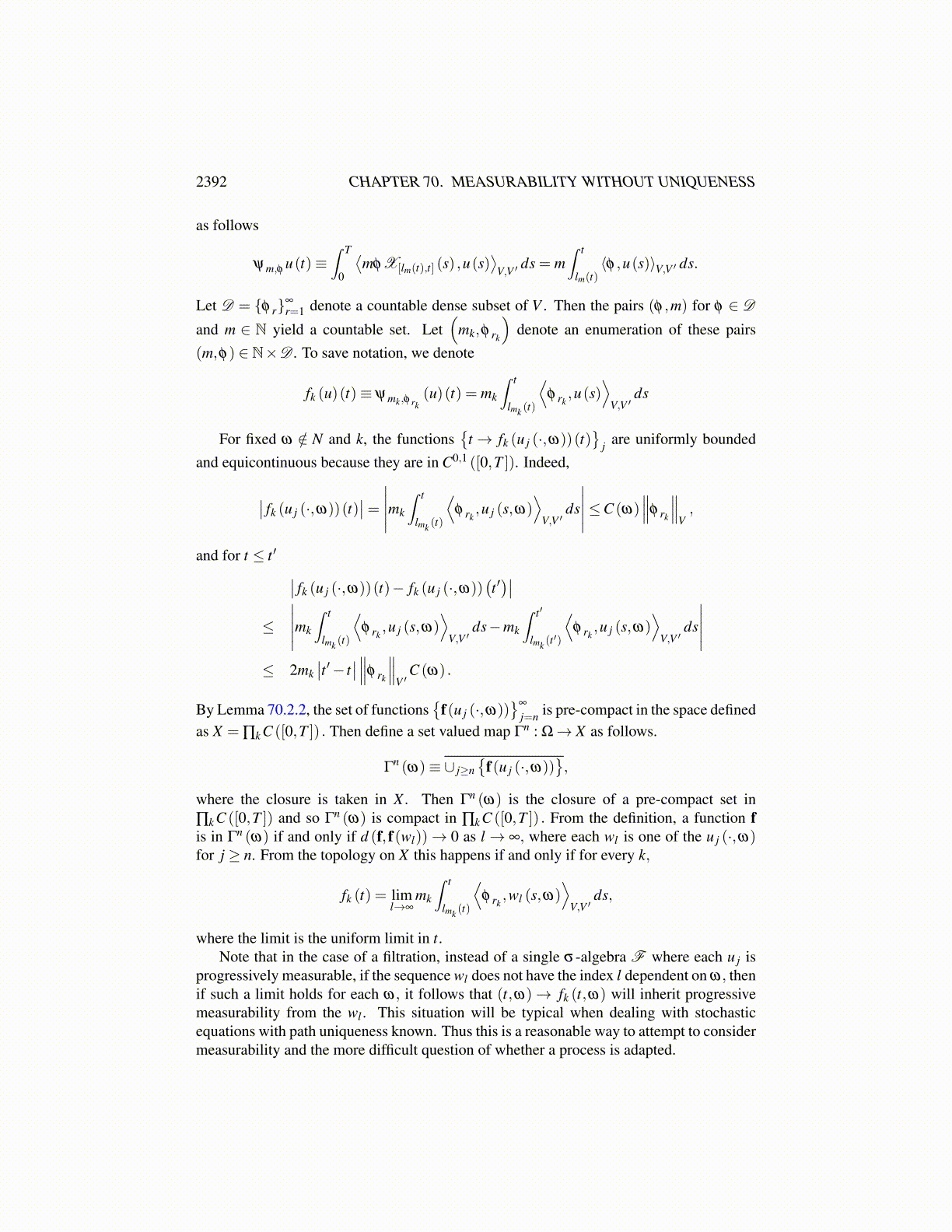
2392 CHAPTER 70. MEASURABILITY WITHOUT UNIQUENESS
{ω : Γ(ω)∩B(xn,1) ̸= /0}∩ [Ω\∪k<n {ω : Γ(ω)∩B(xk,1) ̸= /0}] ∈ C .
Thus we see that ψ1 is measurable and dist(ψ1 (ω) ,Γ(ω))< 1. Let
Ωn ≡ {ω ∈Ω : ψ1 (ω) = xn} .
Then Ωn ∈ C and Ωn∩Ωm = /0 for n ̸= m and ∪∞n=1Ωn = Ω. Let Dn ≡ {xk : xk ∈ B(xn,1)} .
Now for each n, and ω ∈ Ωn, let ψ2 (ω) = xk where k is the smallest index such that xk ∈Dn and B
(xk,
12
)∩Γ(ω) ̸= /0. Thus dist(ψ2 (ω) ,Γ(ω)) < 1
2 and d (ψ2 (ω) ,ψ1 (ω)) < 1.Continue this way obtaining ψk a measurable function such that
dist(ψk (ω) ,Γ(ω))<1
2k−1 , d(ψk (ω) ,ψk+1 (ω)
)<
12k−2 .
Then for each ω,{ψk (ω)} is a Cauchy sequence converging to a point, σ (ω) ∈ Γ(ω) .This has shown that if Γ is measurable there exists a measurable selection, σ (ω) ∈ Γ(ω) .It remains to show there exists a sequence of these measurable selections, σn such that theconclusion of 4.) holds. To do this we define
Γni (ω)≡{
Γ(ω)∩B(xn,2−i
)if Γ(ω)∩B
(xn,2−i
)̸= /0
Γ(ω) otherwise. .
First we show that Γni is measurable. Let U be open. Then
{ω : Γni (ω)∩U ̸= /0}={
ω : Γ(ω)∩B(xn,2−i)∩U ̸= /0
}∪[{
ω : Γ(ω)∩B(xn,2−i)= /0
}∩{ω : Γ(ω)∩U ̸= /0}
]={
ω : Γ(ω)∩B(xn,2−i)∩U ̸= /0
}∪[(
Ω\{
ω : Γ(ω)∩B(xn,2−i) ̸= /0
})∩{ω : Γ(ω)∩U ̸= /0}
],
a measurable set. By what was just shown there exists σni, a measurable function such thatσni (ω) ∈ Γni (ω)⊆ Γ(ω) for all ω ∈ Ω. If x ∈ Γ(ω) , then x ∈ B
(xn,2−i
)whenever xn is
close enough to x. Therefore, |σni (ω)− x|< 2−i. And it follows that condition 4.) holds.Now we verify that 4.) ⇒ 3.). Suppose there exist measurable selections σn (ω) ∈
Γ(ω) satisfying condition 4.). Let U be open. Then
{ω : Γ(ω)∩U ̸= /0}= ∪∞n=1σ
−1n (U) ∈ C .
Now suppose Γ(ω) is compact for every ω and that Γ− (U)∈C for every U open. Thenlet F be a closed set and let {Un} be a decreasing sequence of open sets whose intersectionequals F such that also, for all n, Un ⊇Un+1. Then
Γ(ω)∩F = ∩nΓ(ω)∩Un = ∩nΓ(ω)∩Un
Now because of compactness, the set on the left is nonempty if and only if each set on theright is also nonempty. Thus Γ− (F) = ∩nΓ−1 (Un) ∈ C .
Actually these are all equivalent in the case of complete measure spaces but we do notneed this and it is much harder to show.